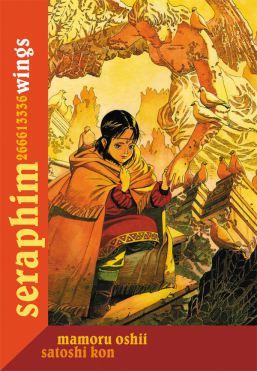 Title: Seraphim 266613336 Wings
Title: Seraphim 266613336 Wings
Genre: Science Fiction
Publisher: Tokuma Shoten Publishing (JP), Dark Horse (US)
Story/Artist: Mamoru Oshii and Satoshi Kon
Serialized in: Animage May 1994 through November 1995
Translation: Zack Davisson
Original Release Date: February 25, 2015
Review copy provided by Dark Horse
While no anime director names are truly well-known in the US, with the possible exception of Hayao Miyazaki, many fans will recognize the names Mamoru Oshii or Satoshi Kon and will certainly recognize at least one of their many works. It’s less well-known that the two did other work outside of directing, much less that they ever collaborated on a manga. As the note from the Japanese editor in the back of the book says, Animage was looking for a replacement for Miyazaki’s Nausicaa of the Valley of the Wind manga which had been a great success for them and so turned to Oshii. Oshii brought on Kon and they ended up working more as co-creators than as an author and artist, although eventually conflicts came up between the two of them and the project was shelved. Kon is dead now, this story will never be finished, and sadly this manga was only in the introductory period of its great, sprawling story and nowhere near a satisfactory, leaving-off point.
As an unfinished work there are many questions left unanswered and the story was clearly setting itself up for a long, deliberate tale. What is presented is thus: sometime in the near future, humanity has been ravaged by a disease where it’s victims slowly begin to grow angelic wings and descend into a madness of hypnotic, alluring hallucinations until they die, shadows of their former selves. The idea seems like something out a science-fiction story more than something from reality and the rest of the story is similarly more interested in setting a mood than staying in the realm of realistic, “hard” science fiction.
The story follows three characters, the Magi Balthazar (Dr. Erasmus) and Melchior (Caspar is actually a basset hound for reasons that were never quite explained within the story) and then a mysterious waif named Sera. To call her a character is an exaggeration — like so many other mysterious young women in fiction she merely stands around, looking unfathomable and yet holds all of the secrets of the world it seems (I’m not even sure if she spoke at all). Balthazar and Melchior fare a little better since Balthazar has goals and Melchior has a past (although if the

As a reader, I dislike dystopias. Written in 1994 and 1995, Seraphim 266613336 Wings does predate the current craze so I can forgive it for that but ultimately I find most of them to be lazily written in regards to setting and the abbreviated length of this story does not help its world-building. It’s hard to believe that one disease, no matter how horrific, has caused modern day society as we know it to collapse all across the globe and I had to raise an eyebrow at a subset of the Catholic Church breaking away and burning people at the stake again (especially when its instigators would have lived before seraphim and would remember a more “civilized” time).
Clearly this is not meant to be a work of realistic fiction but even a fictional setting must have grounding and this single volume of a story simply didn’t provide that. If this was a longer series, even a longer unfinished one, then this would be fine but as it stands it just highlights how poor of a stopping point this was. Carl Gustav Horn, the Dark Horse editor in charge of the manga, has put together a lengthy essay at the back of the book about the work that explains some details better than the manga itself does which does help the reader a bit. In the end, there’s no denying that this was an ambitious work, in both the scale of the art and the story, and it’s that promise it had which makes it’s unfinished ending sting even more.
 Title: Seraphim 266613336 Wings
Title: Seraphim 266613336 Wings
